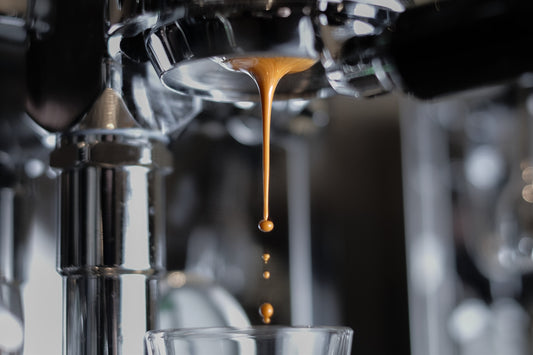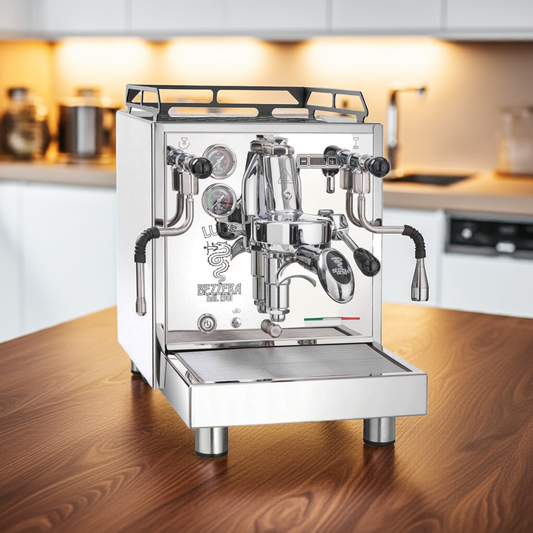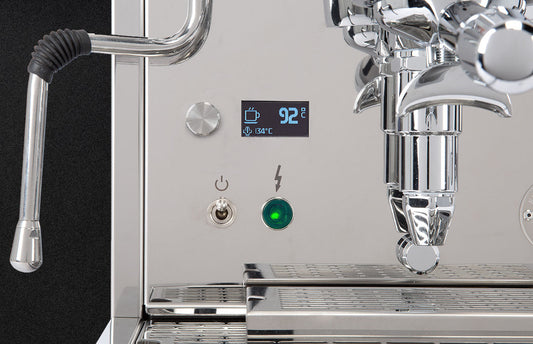The first part of a series of articles on the search for the perfect espresso. Understanding what "brewing ratio" means and how I can use this parameter to systematically improve my espresso extraction is an important step on the path to a perfect espresso.
Brewing ratio - the meaning
Admittedly, the word “brewing ratio” is a rather clumsy translation of the pleasant-sounding English term Brew Ratio . Therefore, I will use the more precise English term in the following.
In principle, the brew ratio is a very simple concept. It simply describes the ratio of ground coffee that I fill into the portafilter and the amount of Espresso that ends up in the cup. A simple example would be the typical Italian espresso with a brew ratio of 1:2.75. From one gram of ground coffee, I want to get 2.75 grams of espresso. With 8 grams of espresso in a single sieve, I would end up with 22 grams of espresso. With crema, this would amount to approximately 25 ml.
How do you work with the brew ratio?
To measure the Brew Ratio you need a Espresso scale that can measure in 0.1 gram increments. First, you weigh the ground coffee to be brewed. This measurement is called "IN." During the brewing process, you measure the amount of espresso that ends up in the cup, called "OUT." One of our most popular roasts has its optimum at 16 grams in and a brew ratio of 1:2.5. Accordingly, you would finish the brewing with 40 grams in the cup.
To make the ratio between IN and OUT work, we need to bring a third factor into the mix: time. Of course, the 40 grams OUT from our example can be achieved in 5, 10, or 25 seconds. However, the first two extractions, at 5 and 10 seconds, would almost certainly be undrinkable. An espresso with 16 grams IN in 25 seconds resulting in an OUT of 40 grams is not suitable for most average coffeemakers. Italian roasts at least drinkable.
The magic triangle - IN | OUT | TIME
To do justice to the word "systematic" from the first few lines, it is important to change the factors slowly and carefully when it comes to the triad of amount of coffee used, extracted beverage and time. First, you should find a basic setup, such as the one mentioned above (IN: 16, OUT: 40, 25 seconds). You change the grind size until the desired brew ratio is reached in the set time. Now the experimenting begins. What happens if I only make 36 grams of espresso at OUT instead of 40 grams? The time and IN remain the same. To achieve this change, the grind size needs to be set finer. Just as well, starting with the basic setup, you could now use 18 grams IN instead of the initially selected 16 grams IN. OUT would still remain at 40 grams in 25 seconds. In this case, the grind size needs to be set coarser in order to achieve the same extraction time with the higher amount of coffee.
With every change in the brew ratio and constant extraction time, you can discover a different facet of the espresso beans. If you continually return to the basic setup and start exploring from there, you'll essentially get to know the roast better and better. It's interesting to note that you often find the same brew ratio to be very suitable for different beans. Of course, this only applies if the beans have a similar character and aren't roasted completely differently.
Trust your own feelings
The considerations around the topic of brew ratio often lead to a significantly better espresso, but you should Fun to prepare Don't lose sight of this. Handling a scale with every espresso isn't enjoyable for most home baristas in the long run. Taking your own espresso to the next level is a great way to spend a dreary Sunday morning. You should memorize your newly acquired knowledge and then try to implement and recognize it without measuring equipment. If you're in the mood, you can test yourself from time to time. A very renowned barista once summed it up quite aptly, saying something like this: “The skill of a carpenter is not measured by his ability to handle a ruler.”




